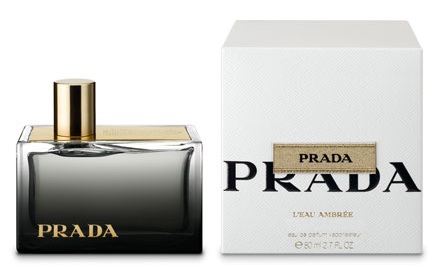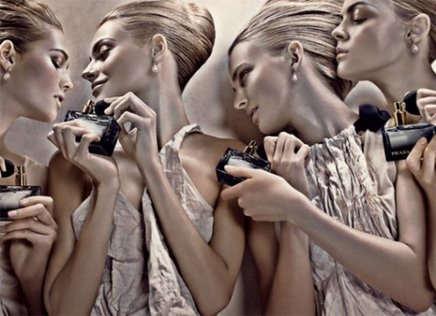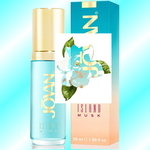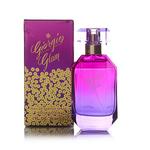Prada L'Eau Ambrée (2009): Refined Amber {Perfume Short (Review)}

Notes: mandarin and lemon essences from Italy, May rose absolute, gardenia jasminoide, amber, patchouli leaves from Indonesia, vanilla, opoponax from Somalia.
As its name seems to indicate L'Eau Ambrée by Prada (Ambery Water) could a priori be thought of as a watercolor rendition of an amber perfume, as in a water tinged with an infusion of sea-floating ambergris. The first thought that came to my mind as I lifted the bottle of the latest fragrance by Prada and as I realized that I was starting to slightly purse my lips was that {sigh}, I should probably expect a copy of or at best a twist on L'Eau des Merveilles by Hermès, or its even more ambery sister, L'Elixir des Merveilles. The market is nowadays so unafraid of launching me-too scents that this is one of the parameters you have to keep in mind when discovering a new fragrance.
But in fact the perfume composed by perfumer Daniela Andrier of Givaudan, is more like a coming-together of the Prada amber perfume line and the Prada Infusion collection on which she has worked consistently with a showcasing of her know-how for creating modern, elegant adaptations of Eau de Cologne as in Infusion d'Iris, Infusion d'Iris for Men and Infusion de Fleurs d'Oranger...

L'Eau Ambrée demonstrates her maestria. It is not only refined in personality but also literally shows a refinement of previous ideas developed with the Infusion series.
At first, L'Eau Ambrée hits the nostrils seemingly appearing to be a mainly one-note amber scent, a slightly old-fashioned, and low-key powdery one, the kind that you would have been able to buy at an apothecary were you a 19th century lady or gentleman and wanted to dab some discreet touches of it on your handkerchief in a practice that was fashionable in the 19th century and early 20th century. It reminds me in fact of a minuscule, flat bottle of Ambre de Rancé that I purchased several years ago in a pharmacy in the Latin Quarter in Paris as I was struck by its oddness and puzzled by the "soliflore" or as I like to say "solabestia" aspect of the perfume. It looked old-fashioned and mysterious. The mini flacon makes you think of the salts that women would carry and would need whenever they felt overly strangled in their corsets. It evokes the gesture of refreshing your temples with just a few dabs of aromatic water.
The perfume as it turns out is a delicate and even delightful composition when the time comes for the rose to make its entrance. In spite of its name, the scent is not at all aquatic, but rather sheer, light, ideal, but most of all, subtle. The beginning may appear too much of a straight-amber prelude to some -- a little in the direction of Cashmere Mist -- but soon you can sense the first fluttering nuances of lemon appearing as a discreet luminous counterpoint to the amber that adds, I want to say a near-mythical hesperidic nuance to it -- to reference the garden of the Hesperides -- as there is something about this accord which evokes the idea of perfection and makes you think of an ideal, measured and ethereal garden inhabited by rarefied other-wordly creatures where citrus fruits are like golden apples. The lemony nuance contributes to a light chypré effect.
After the classic, light ambery opening with its eau-de-cologne facet, floral overtones intervene that add all the interest to this fragrance. There is suddenly an unexpected sweet orange blossom note that appears enriched by a subtle, deeper signature of the resinous opoponax. The "eau" aspect is very faintly fruity and melon-y. There seems also here to be understated, covert quotes of l'Heure Bleue and Après L'Ondée by Guerlain but also perhaps some tonalities from Royal Secret by Germaine Monteil.
A truly delightful and glee-inducing moment emerges as the rose, May rose, blooms in the heart of the perfume together with gardenia. The rose-amber accord although light is precious, evocative of the ancient splendors of the well-red-heeled at the court of Versailles, an image perhaps brought about by the orange blossom note and a certain ancient and precious courtly qualities pertaining to the composition.
In contrast to the original Amber by Prada which revealed a bold and assertive temperament, L'Eau Ambrée is a refined amber perfume all in semi-tonalities. In this sense it can be seen to be a perfume which is like an aquarelle in which amber, citrus, flowers, rose, patchouli, spices were painted delicately and in an inspired manner. The perfume is soft-focused, discreet like a nude makeup. It is tasteful without being boringly conservative. It has so many qualities that I would consider this fragrance to be one of the easiest to offer to a large circle of persons, a remark I already made for Infusion d'Iris. Its understated, elegant signature makes it fit for all sorts of different social occasions. Refined and versatile, how could you ask for more?










Thanks for such a detailed review! I'm so interested to try this one. I love amber perfumes, and I'm intrigued by the idea of a lighter iteration. Most of my collection falls into the "Queen of Sheba" territory.
really curious about this one... hope it will hit the dutch stores soon... ;-)
nice review
;-)